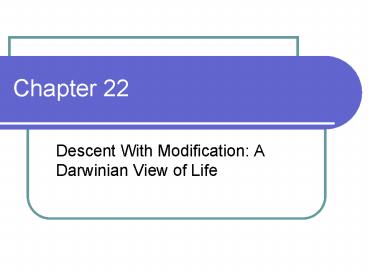Descent With Modification: A Darwinian View of Life - PowerPoint PPT Presentation
1 / 14
Title:
Descent With Modification: A Darwinian View of Life
Description:
Title: Chapter 15 Author: Kennewick School District Last modified by: Kennewick School District Created Date: 3/28/2005 11:01:24 PM Document presentation format – PowerPoint PPT presentation
Number of Views:123
Avg rating:3.0/5.0
Title: Descent With Modification: A Darwinian View of Life
1
Chapter 22
- Descent With Modification A Darwinian View of
Life
2
Jean Baptiste Lamarck
- Lamarck (1809) proposed a mechanism by which
specific adaptations evolve, which included two
related principles - 1. Use and disuse Body organs used
extensively to cope with the environment become
larger and stronger while those not used
deteriorate. - 2. Inheritance of acquired characteristics
Modifications an organism acquired during its
lifetime could be passed along to its offspring. - Ex birds wings, giraffes necks.
- Experiments and new knowledge have disproven
Lamarck (mice tails experiment)
3
(No Transcript)
4
Charles Darwin
- Darwin, serving as ships naturalist on the
H.M.S. Beagle, observed unique species on the
South American coast including the Galapagos
Islands. - Published On the Origin of Species by Means of
Natural Selection in 1859. - Made two major points
- 1. Species evolved from ancestral species due
to inheritable variations. - 2. Natural selection is a mechanism that could
result in this evolutionary change.
5
Darwins Theory
- Natural selection Due to survival of the
fittest, organisms with certain traits survive to
reproduce this results in changes in inherited
characteristics of a population over time. - Transmutation (descent with modification)
species have descended, with changes, from other
species over time.
6
(No Transcript)
7
Evidence Presented
- Fossil record shows how organisms on earth have
changed over time. - Record has gaps difficulty finding accurate
age.
8
(No Transcript)
9
Evidence Presented cont.
- Homologous structures -- organisms have similar
structures used for similar purposes. - Did they have a common ancestor?
10
Evidence Presented cont.
- Vestigial structures -- organs that serve no
purpose, but resemble those found in other
organisms. - Scientists are still discovering functions.
11
Evidence Presented cont.
- Comparative embryology -- embryos of vertebrates
look similar in early stages. - Did they have a common ancestor?
- Early sketches were exaggerated.
12
Evidence cont. Biogeography
13
The New Frontier
- Comparative biochemistry --The DNA revolution has
disproven and supported some old ideas. - Similar DNA sequences may tell which species are
more closely related.
14
More on Natural Selection
- Variations in a population arise by chance
through mutation and recombination during sexual
reproduction. - Darwins view of Gradualism
- Life evolved by a gradual accumulation of small
changes over vast spans of time. - Or Punctuated equilibrium (S.J. Gould)
- Species have long periods of no change, then
short periods of drastic change, due to intense
environmental pressure.































